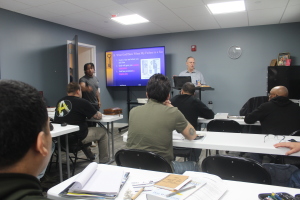The Social Costs of Abandoning the Meaning of Marriage
Marriage plays a fundamental role in civil society because it is characterized by sexual complementarity, monogamy, exclusivity, and permanence. These marriage norms encourage men and women to commit permanently and exclusively to each other and take responsibility for their children. [1]
In recent decades, a revisionist view of marriage has eroded these norms. No-fault divorce was the first major trend to undermine a strong marriage culture. Now the effort to redefine marriage away from male-female complementarity has gone even further in abandoning the central characteristics of the institution. But if the law redefines marriage to say the male-female aspect is arbitrary, what principle will be left to retain monogamy, sexual exclusivity, or the expectation of permanency? [2] Such developments will have high social costs.
The New Language of Marriage
New terms have even been coined to describe this new outlook on marriage. Here are some examples.
"Monogamish." A 2011 New York Times profile of gay activist Dan Savage, headlined "Married, with Infidelities," introduced Americans to the term monogamish-relationships where partners would allow sexual infidelity provided they were honest about it.[3]
The article explained: "Savage says a more flexible attitude within marriage may be just what the straight community needs." After all, the story added, sexual exclusivity "gives people unrealistic expectations of themselves and their partners." Rather than strive for faithfulness to one spouse, advocates argue for allowing marriage to be sexually open.
Polyamory and "Throuple." If marriage can be redefined to be sexually open, why should it be limited to two people in the first place? The liberal online journal Salon in August 2013 posted a woman's account of her shared life with a husband, boyfriend, and daughter under the headline "My Two Husbands." The subhead: "Everyone wants to know how my polyamorous family works. You'd be surprised how normal we really are."[4]
A certain type of polyamorous relationship has even motivated advocates to create the word throuple, which is similar to "couple" but with three people. The word appeared in a 2012 article in New York Magazine that described a specific "throuple" this way:
Their throuplehood is more or less a permanent domestic arrangement. The three men work together, raise dogs together, sleep together, miss one another, collect art together, travel together, bring each other glasses of water, and, in general, exemplify a modern, adult relationship.[5]
"Wedlease." The word wedlease was introduced in an August 2013 op-ed in The Washington Post.[6] Why should marriage be permanent when so little else in life is, the author wondered. Why not have temporary marriage licenses, as with other contracts? "Why don't we borrow from real estate and create a marital lease?" the author wrote. "Instead of wedlock, a 'wedlease.'" He continues:
Here's how a marital lease could work: Two people commit themselves to marriage for a period of years-one year, five years, 10 years, whatever term suits them. The marital lease could be renewed at the end of the term however many times a couple likes.… The messiness of divorce is avoided and the end can be as simple as vacating a rental unit.
What Is Marriage?
Whatever one thinks about the morality of sexually open marriages, multi-partner marriages, and by-design-temporary marriages, the social costs will run high. The marital norms of monogamy, sexual exclusivity, and permanency make a difference for society. These new words and the reality they reflect undermine public understanding of what marriage is and why it matters for society.[7]
At its most basic level, marriage is about attaching a man and a woman to each other as husband and wife to be father and mother to any children their sexual union produces. When a baby is born, there is always a mother nearby: That is a fact of reproductive biology. The question is whether a father will be involved in the life of that child and, if so, for how long. Marriage increases the odds that a man will be committed to both the children that he helps create and to the woman with whom he does so.
Marriage, rightly understood, brings together the two halves of humanity (male and female) in a monogamous relationship. Husband and wife pledge to each other to be faithful by vows of permanence and exclusivity. Marriage provides children with a relationship with the man and the woman who made them.
If a man does not commit to a woman in a permanent and exclusive relationship, the likelihood of creating fatherless children and fragmented families increases. The more sexual partners a man has, and the shorter lived those relationships are, the greater the chance he creates children with multiple women. His attention and resources thus divided, a long line of consequences unfold for both mother and child, and for society as a whole.
Why Does Marriage Matter?
Marriage is thus a personal relationship that serves a public purpose.[8] According to the best available sociological evidence, children fare best on virtually every examined indicator when reared by their wedded biological parents. Studies that control for other factors, including poverty and even genetics, suggest that children reared in intact homes do best in terms of educational achievement, emotional health, familial and sexual development, and delinquency and incarceration.[9]
The breakdown of marriage most hurts the least well off. A leading indicator of whether someone will know poverty or prosperity is whether, growing up, he or she knew the love and security of having a married mother and father. Marriage reduces the probability of child poverty by 80 percent.[10]
Marital breakdown harms society as a whole. A Brookings Institution study found that $229 billion in welfare expenditures between 1970 and 1996 can be attributed to the breakdown of the marriage culture and the resulting exacerbation of social ills: teen pregnancy, poverty, crime, drug abuse, and health problems.[11] A 2008 study found that divorce and unwed childbearing cost taxpayers $112 billion each year,[12] and Utah State University scholar David Schramm has estimated that divorce alone costs federal, state, and local governments $33 billion each year.[13]
Recognition of marriage serves the ends of limited government more effectively, less intrusively, and at less cost than does picking up the pieces from a shattered marriage culture.
Someone might object: What does it matter if a small percentage of marriages are open, group, or temporary? Those arguments were made in the no-fault divorce debate in the 1960s, but the introduction of such laws had a dramatic impact. After all, law affects culture. Culture affects beliefs. Beliefs affect actions. The law teaches, and it will shape not just a handful of marriages but the public understanding of what marriage is.
Restoring the Marriage Norms
Ideas and behaviors have consequences. The breakdown of the marriage culture since the 1960s made it possible in this generation to consider redefining marriage in the law to exclude sexual complementarity. And that redefinition may lead to further redefinition.
Indeed, these new concepts make marriage primarily about adult desire, with marriage understood primarily as an intense emotional relationship between (or among) consenting adults. This revisionism comes with significant social costs.
Redefining marriage to say that men and women are interchangeable, that "monogamish" relationships work just as well as monogamous relationships, that "throuples" are the same as couples, and that "wedlease" is preferable to wedlock will only lead to more broken homes, more broken hearts, and more intrusive government. Americans should reject such revisionism and work to restore the essentials that make marriage so important for societal welfare: sexual complementarity, monogamy, exclusivity, and permanency.
Click here to see a complete list of footnotes and references for this column.





























